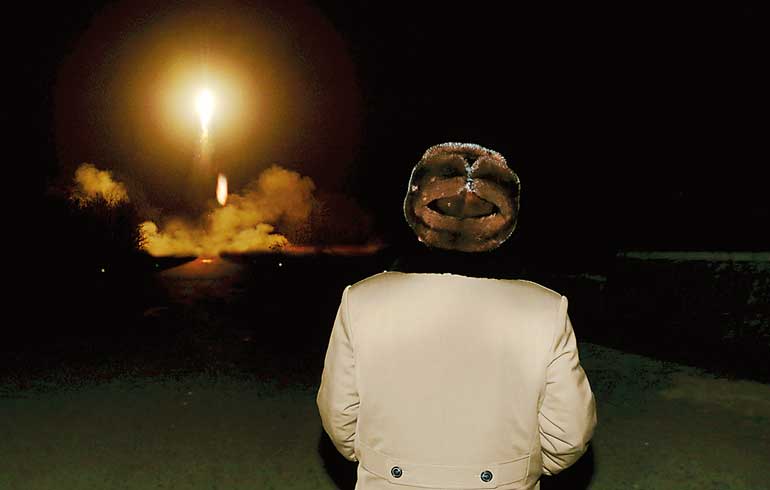Wednesday Feb 12, 2025
Wednesday Feb 12, 2025
Wednesday, 20 July 2016 00:00 - - {{hitsCtrl.values.hits}}

Reuters: North Korea fired three ballistic missiles early on Tuesday which flew between 500 and 600 kms (300 and 360 miles) into the sea off its east coast, South Korea’s military said, the latest in a series of provocative moves by the isolated country.
The U.S. military said it detected launches of what it believed were two Scud missiles and one Rodong, a home-grown missile based on Soviet-era Scud technology.
North Korea has fired both types numerous times in recent years, an indication that unlike recent launches that were seen as efforts by the North to improve its missile capability, Tuesday’s were meant as a show of force.
“This smells political rather than technical to me,” said Melissa Hanham, a senior research associate at the U.S.-based Middlebury Institute of International Studies at Monterey, California.
“I think the number and distance of the missiles lets them remind the ROK (Republic of Korea) of what they are up against,” she said, referring to South Korea by its official name.
The launches came days after South Korea and the United States announced a final decision to deploy the Terminal High Altitude Area Defence (THAAD) anti-missile system in the South to counter threats from the North, which had prompted Pyongyang to threaten a “physical response.”
“Our assessment is that it was done as a show of force,” a South Korean Joint Chiefs of Staff official said at a briefing.
The missiles were launched from an area in the North’s western region called Hwangju between 5:45 a.m. South Korea time (2045 GMT Monday) and 6:40 a.m., the South’s military said, an indication that the North was confident they would not crash on its own territory.
“The ballistic missiles flight went from 500 km to 600 km, which is a distance far enough to strike all of South Korea, including Busan,” the South’s military said in a statement.
Busan is a South Korean port city in the south.
North Korea has test-fired a series of ballistic missiles in recent months, in defiance of United Nations Security Council resolutions, including intermediate-range missiles in June and a submarine-launched missile this month. “In addition to the basic goal of enhancing missile units’ readiness to fight, it might be a way of reminding their southern neighbors that the site chosen for a THAAD battery in South Korea is within reach,” Joshua Pollack, editor of the U.S.-based Nonproliferation Review, said of Tuesday’s launches.
South Korea announced last week the THAAD system would be deployed in the southeastern county of Seongju.
In addition to the decision to base a THAAD system in South Korea, the United States recently angered North Korea by blacklisting its leader Kim Jong Un for human rights abuses.
“The threat to our national security is growing very quickly in a short period of time,” South Korean Prime Minister Hwang Kyo-ahn told parliament on Tuesday.
North Korea conducted its fourth test of a nuclear device in January, and activity at its nuclear test site has increased recently, according to media reports in South Korea and Japan citing government officials, as well as a report by Washington-based North Korea monitoring project 38 North.
Discover Kapruka, the leading online shopping platform in Sri Lanka, where you can conveniently send Gifts and Flowers to your loved ones for any event including Valentine ’s Day. Explore a wide range of popular Shopping Categories on Kapruka, including Toys, Groceries, Electronics, Birthday Cakes, Fruits, Chocolates, Flower Bouquets, Clothing, Watches, Lingerie, Gift Sets and Jewellery. Also if you’re interested in selling with Kapruka, Partner Central by Kapruka is the best solution to start with. Moreover, through Kapruka Global Shop, you can also enjoy the convenience of purchasing products from renowned platforms like Amazon and eBay and have them delivered to Sri Lanka.
Discover Kapruka, the leading online shopping platform in Sri Lanka, where you can conveniently send Gifts and Flowers to your loved ones for any event including Valentine ’s Day. Explore a wide range of popular Shopping Categories on Kapruka, including Toys, Groceries, Electronics, Birthday Cakes, Fruits, Chocolates, Flower Bouquets, Clothing, Watches, Lingerie, Gift Sets and Jewellery. Also if you’re interested in selling with Kapruka, Partner Central by Kapruka is the best solution to start with. Moreover, through Kapruka Global Shop, you can also enjoy the convenience of purchasing products from renowned platforms like Amazon and eBay and have them delivered to Sri Lanka.